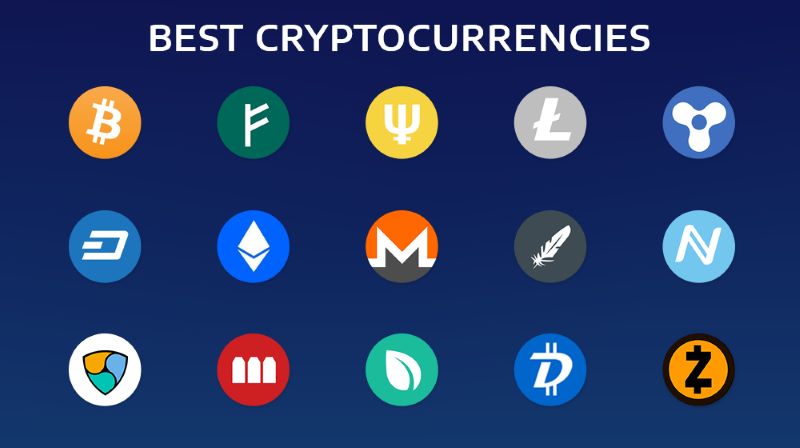The cryptocurrency landscape can be overwhelming for newcomers and experienced investors alike. With thousands of digital currencies competing for attention, it’s vital to recognize the leading contenders and the factors behind their success. While Bitcoin remains a household name, the most promising cryptocurrencies are emerging, ready to reshape the future of digital assets and investment opportunities.
Top 10 Most Promising Cryptocurrencies
This exploration delves into the top 10 cryptocurrencies, examining their unique attributes, market presence, and potential for future growth. From established players like Bitcoin and Ethereum to emerging contenders like Solana and Toncoin, we’ll provide insights into what makes these digital assets stand out in a crowded market.
Bitcoin (BTC): The Undisputed King
Bitcoin, often referred to as digital gold, holds the title of the first and most valuable cryptocurrency. With a market capitalization exceeding $1.3 trillion, Bitcoin continues to dominate the market. Its decentralized nature, limited supply, and growing acceptance by institutions solidify its position as a store of value and a hedge against inflation.
Ethereum (ETH): The Smart Contract Pioneer
Ethereum revolutionized the crypto space by introducing smart contracts, self-executing contracts that automate transactions and enable decentralized applications (dApps). With a market cap exceeding $374 billion, Ethereum’s blockchain hosts a vast ecosystem of dApps, NFTs, and DeFi protocols, driving innovation and attracting developers worldwide.
Tether (USDT): The Stablecoin Giant
Tether, a stablecoin pegged to the US dollar, offers stability and minimizes volatility, making it a popular choice for traders and investors seeking refuge from market fluctuations. With a market cap surpassing $111 billion, Tether provides a bridge between the crypto and traditional financial worlds, facilitating seamless transactions and stablecoin pairings.
Binance Coin (BNB): The Utility Powerhouse
Binance Coin, the native token of the Binance exchange, boasts a diverse range of utilities within the Binance ecosystem and beyond. With a market cap of $89 billion, BNB offers discounted trading fees, participation in token sales, and access to various services on the Binance platform, making it a valuable asset for frequent traders and investors.
Solana (SOL): The Scalability Champion
Solana has gained significant traction for its high-speed transaction processing and low fees. With a market cap exceeding $76 billion, Solana’s innovative proof-of-history consensus mechanism enables it to handle thousands of transactions per second, positioning it as a potential solution to scalability challenges faced by older blockchains.
USD Coin (USDC): The Regulated Stablecoin
USD Coin, another prominent stablecoin pegged to the US dollar, differentiates itself through its regulatory compliance and transparency. With a market cap exceeding $33 billion, USDC provides a trustworthy and stable option for businesses and individuals seeking a digital equivalent to the US dollar, particularly for cross-border transactions and remittances.
Ripple (XRP): The Cross-Border Payment Solution
Ripple aims to revolutionize cross-border payments with its fast and low-cost transaction network. With a market cap exceeding $28 billion, XRP facilitates near-instantaneous international money transfers, offering a compelling alternative to traditional SWIFT system, particularly for financial institutions seeking faster and more cost-effective solutions.
Dogecoin (DOGE): The Meme Coin with a Loyal Following
Dogecoin, initially created as a lighthearted meme, has surprisingly gained a massive following and a market cap surpassing $21 billion. While lacking the technological advancements of other cryptocurrencies, Dogecoin’s strong community support and occasional endorsements from high-profile figures contribute to its price volatility and enduring popularity.
Toncoin (TON): The Telegram-Backed Network
Toncoin, originally developed by Telegram, aims to build a decentralized and scalable network for messaging, payments, and other applications. With a market cap of $20 billion, Toncoin leverages Telegram’s vast user base and infrastructure to foster adoption and create a comprehensive ecosystem for decentralized services.
Cardano (ADA): The Research-Driven Platform
Cardano distinguishes itself through its scientific and research-driven approach to blockchain development. With a market cap exceeding $17 billion, Cardano emphasizes security, scalability, and sustainability, aiming to create a robust platform for dApps, smart contracts, and other blockchain solutions. Its focus on peer-reviewed research and academic rigor positions Cardano as a promising contender for long-term growth.
What is Cryptocurrency and How Does it Work?
Cryptocurrency is a digital or virtual form of currency that uses cryptography for security. It operates independently of central banks and governments, relying on decentralized networks called blockchains to record and verify transactions. This decentralized nature offers transparency, security, and resistance to censorship.
The History and Evolution of Digital Currencies
The concept of digital currencies predates Bitcoin. However, Bitcoin’s launch in 2009 marked a pivotal moment, introducing the world to the first successful decentralized cryptocurrency. Since then, thousands of cryptocurrencies have emerged, each with unique features and applications, ranging from stablecoins pegged to fiat currencies to privacy-focused coins and platform tokens powering decentralized applications.
Why are These Cryptocurrencies Considered Top Performers?
Several factors contribute to the prominence and potential of these top 10 cryptocurrencies.
Market Capitalization and Liquidity
Market capitalization, calculated by multiplying the current price by the total number of coins in circulation, reflects the overall value and market dominance of a cryptocurrency. High market cap cryptocurrencies like Bitcoin and Ethereum typically enjoy greater liquidity, making it easier to buy and sell large amounts without significantly impacting the price.
Technological Innovation and Development
The crypto space is driven by constant innovation. Cryptocurrencies at the forefront of technological advancements, such as Ethereum’s smart contracts or Solana’s high-speed transaction processing, tend to attract developers and investors alike, fostering growth and expanding the possibilities of blockchain technology.
Real-World Use Cases and Adoption
Cryptocurrencies with tangible real-world applications and growing adoption beyond speculation tend to hold greater long-term value. For instance, stablecoins like Tether and USDC are increasingly used for payments, remittances, and as a hedge against inflation in countries with unstable currencies.
The world of cryptocurrency is dynamic and constantly evolving, offering both opportunities and challenges. By understanding the fundamentals, exploring the leading contenders, and approaching investments with caution and diligence, individuals can navigate this exciting and potentially lucrative asset class. As with any investment, thorough research, careful consideration of risk tolerance, and a long-term perspective are essential for success in the ever-changing world of cryptocurrency.

